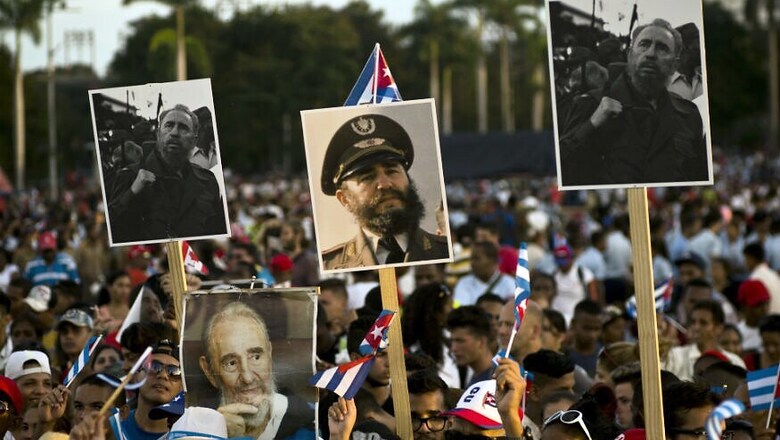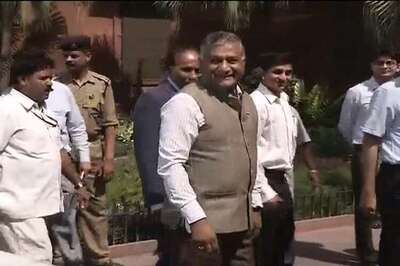
views
Santiago: About a year ago, trucks full of building materials began arriving at the Santa Ifigenia cemetery in the eastern Cuban city of Santiago. On Saturday, a white cloth was draped over a new structure near the mausoleum for Cuban independence leader Jose Marti.
Beyond those few clues, the details of Fidel Castro's final resting place have been one of the most tightly kept secrets in Cuba. That is expected to end on Sunday morning, when the revolutionary leader's ashes are interred in a ceremony expected to give the world at least a brief glimpse of a tomb that will immediately become one of the most important sites on the island.Also Read: Cuba Will Ban Naming of Monuments After Fidel: Raul Castro
Cuban officials have said nothing about future access to Castro's tomb, but its apparent location alongside Marti's, a grand site heavily visited by tourists and Cubans alike, indicates that there will be some form of public access to the grave of the man who led Cuba for nearly 50 years and died on November 25 at 90.
"It's a privilege to have him here," said Cruz Maria Pardo, 64, who worked at the cemetery cleaning the mausoleums for more than 20 years and said she had seen trucks bringing in materials for a little over a year.
Thousands if not millions of Cubans have lined the central roadway connecting the island's two largest cities over the last four days, chanting and waving banners as the cedar coffin carrying his remains drove by. In the country's vast, rural stretches, Cubans packed into buses and tractor trailers, many as part of work or school groups, to wait hours under a blistering sun to say goodbye.Also Read: Celebration, Sorrow Mingle After Death of Fidel Castro
On Sunday, his remains reached Santiago, the city where Castro launched his revolution and where a final, mass gathering in the city's Revolution Plaza was held before his ashes are interred at Santa Ifigenia.
The cemetery is located in the northwestern part of Santiago, about a half-kilometer from the bay. It was founded in 1868 and is the final resting place of some of the most important figures in Cuban history. Beyond a stately, white building at the entrance lies Marti's large mausoleum, a tower where there is a changing of the guard every half hour. Nearby stands a memorial to rebels killed in or executed by Batista's forces after the 1953 attack on the Moncada Barracks, Castro's initial, failed attempt to foment revolution.
"It's been a while since they've been bringing materials," said Roberto Lamar Herrera, 73, a retired railroad manager.
"We are going to take care of him," said his daughter, Ileana Lamar Rodriguez, 50.
Further into the cemetery lies the tomb of Compay Segundo, the singer and guitarist who garnered worldwide fame as a member of the Buena Vista Club. His above-ground tomb bears the image of a golden guitar, cloaked in one of his signature Panama hats.
Santa Ifigenia also houses the remains of historic figures whose families fled after the revolution and are seldom mentioned by officials, like Emilio Bacardi Moreau, who managed his family's rum dynasty and died in 1922. The Bacardi family left Cuba in the early years of the revolution after their properties were nationalized by the Castro government.
"All of the revolution's history is concentrated at that cemetery," said Jose Francisco Guillot Castillo, 59, a cook in an oil refinery who lives in a house with a tin roof on the nearby Raul Perozo Avenue.
Residents along the winding street spent Saturday making signs with revolutionary phrases like "I am Fidel," and hanging Cuban flags from their doorways. The street is named after a revolutionary fighter who residents say was dragged through the street and killed by Batista's forces. Today it is a mix of crumbling brick homes and new cinderblock constructions in bright coats of blue and aqua paint. The residents include a mix of factory workers, retired revolutionary combatants, engineers and students. A few signs for private business, including one specializing in eyeglass repair, line the street.
Early Saturday morning there were some state security officials on the street, several of which questioned an Associated Press reporter doing interviews with residents on the street and stood watch nearby as she proceeded to report.
Eugenio Rodriguez Fonseca, 82, who said he was part of the revolution's clandestine operations, stood outside his home, six golden metals commemorating his participation pinned to a worn white collared shirt.
"I'm crying inside," he said as his great-granddaughter sat nearby, the name "Fidel" painted across her forehead.
When Castro's funeral caravan passes by, he said he planned to render one final salute.




















Comments
0 comment